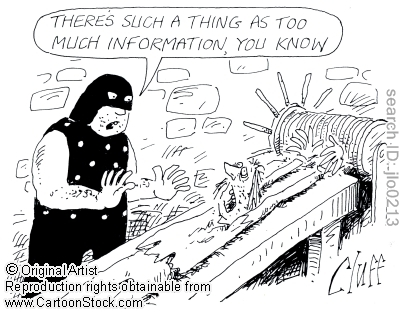Compliance Can Be Torture For Consumers





by Tony Vidler ![]()
![]()
![]()

Compliance has a lot to answer for. Compliance can be torture for consumers, and that is not good for them or the industry.
One of the truly negative consequences of evolving best practice advice standards is the trend to torture clients with excessive paperwork. Now torture is a rather harsh word, and I am sure that globally there is no particular agenda on the part of regulators or professional advisers or service providers to deliberately create torment for consumers.
Nevertheless, processes are imposed upon industry and consumers by well-meaning folk who have forgotten (or never knew) what it is to work through a professional advice process themselves. So a process is created and the powers-that-be say “this won’t hurt – much“…and then wonder why the industry and consumer’ approach to utilising the financial advice process is treated with distinct trepidation?
Perhaps the areas where this torture occurs most frequently, and unnecessarily, are the aspect of the advice process focused upon uncovering the facts and dreams and ambitions and goals of clients, followed by the part where we have to evidence the worthiness of the recommendation solution or action.
The concept of determining what matters to the customer, and ensuring that you have all the appropriate information to be able to provide good objective and sound advice is totally valid. It is a necessity if good advice is to be provided that can actually be valuable to a customer, and be valued by them.
The problem is how the industry approaches the task.
An adviser and potential client are happily discussing the way ahead, and the client consents to engaging in the advice process. Out comes the 10-20 page discovery document…with oodles of boxes to be filled in…many of them with dollar signs just aching to have a number attached to them….and lots more boxes requiring precise data covering pretty much everything from knowing the zodiac signs of all offspring, current or potential, through to the complete medical history of your grandmother whose full name most consumers could not accurately recall.
Guess what the client is thinking when they see this process coming at them?

Generally they don’t feel any better about it if we pull out a tablet or laptop and do it electronically instead….they can still see the boxes on the screen…they know what’s coming….
…and so begins the process of disengagement by the consumer.
So why do we torture them?
The problem is not the data-gathering process as such. Nor is the problem that we do actually require quite a lot of information to do the job well. The problem – the torture – is imposed by those in charge of distribution or advice channels.
They design or insist upon processes that cover the institutions requirements, not the consumers or the advisers.

Whilst I am an avid supporter of a good advice process, and thoroughly understanding the client’s situation, we need to find ways to make the process less intimidating and more engaging. From that perspective it is still difficult in my view to beat the old fashioned blank sheet of paper.
You did read that right.…I love gadgets, technology, and cool apps as much as the next person…and fully agree that we need to get a lot of information to be able to do the job professionally and completely. But it is the adviser who should have the skill to question and determine relevance of information, and for the consumer to be able to take the fact-finding discussion in directions which are meaningful for them. So I still feel that a blank piece of paper is the way to go.
You see, when you sit in front of a client with a blank sheet of paper you are subliminally suggesting a number of positive things to them:
1. this process is about them, not you.
2. there are no preconceived or preset paths to be taken.
3. you are entirely focused on them, and paying attention to what they are saying.
4. you know your stuff – you know what you need to do; you know what you have to get; you know where you are going with this process.
5. you are actually really listening to them.
If you want to break down the barriers in your business and get higher levels of engagement and participation by clients consider going old school for some parts of your process. A blank sheet of paper can still be compliant – if you have done your work properly and gathered the required information. It isn’t the tool that does the job, it is you. A tool is just a tool – an inanimate object that does nothing valuable until it is used properly by an artisan.
Remember that the ultimate sophistication is simplicity.
Some simple things have stood the test of time because they were the best ways of doing things. And the least painful ways. Torturing clients with painfully long and intrusive forms is no way to increase either confidence or participation in the use of financial advice.
You might also be interested in this related article:
Comments (0)